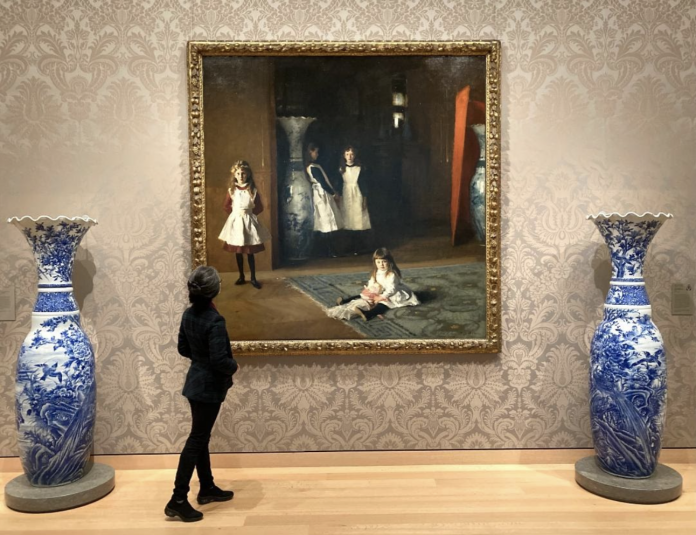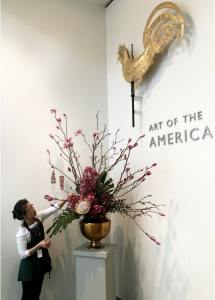When the Museum of Fine Arts re-opened in February, I went directly to Gallery 232 in the Art of the Americas to see The Daughters of Edward Darley Boit. It’s one of the best-known paintings by John Singer Sargent, who also painted the murals in the rotunda of the museum. The eldest Boit daughter is thirteen in this painting, the same age I was when we escaped Vietnam forty-five years ago today. I have four younger sisters and over my three decades living in Boston, I have looked at the painting many times, thinking about my sisters and where they have settled across the United States.
The painting lives between two six-foot-tall, blue-and-white Japanese vases — the same ones that appear in the portrait. These vases went with the Boits back and forth between their Paris and Boston homes sixteen times. It’s my goal to cross the Atlantic as many times. Right now, no one can predict exactly when we can travel safely again, yet I dream of Paris. My learned response for survival is hope paired with actions. Call it refugee reflex. I hope for Paris while wearing my masks, doubling them, maintaining social distance, and waiting for the vaccine.
Similar to life in a pandemic, life as a refugee combines fear, loss, and sadness. We refugees cannot be despondent in a crisis. My parents lost their homes, jobs, and relatives as we fled from Vietnam. My father worked with the Americans to fight the North Vietnamese Communist government who had won the war. He would have been executed if we remained in Vietnam. Normalcy ended for me the day we lunged for the fishing boat.
One thing we never let go of was hope. My parents nearly named their youngest son, born three days after landing in this country, Hope, but an obstetric nurse told them Hope is a girl’s name. Outside of hope, we clung to work, the relentless bone-tiring struggle to form a new life. It was much like life in a pandemic. There were constant evolving new requirements.
My parents talked about the future even as we climbed barefoot onto a rescuing merchant vessel, lived in one of the tents in a makeshift camp under the punishing sun in Guam Island, and waited for sponsors in an army barrack turned refugee camp. We rarely took time to mourn the past. We made plans to go to school, learn English, and find jobs once we were on the other side. We dreamed of life on the other side of a refugee camp’s fence. I think about this longing for normalcy when my friends tell me I can’t wait to have dinner with you, on the other side of this pandemic. I want to tell my friends there is no going back to normal, even on the other side.
We work to get to the other side, and then we continue to work when on the other side, for physical survival and emotional stability. During the eighties, only ten years after my resettlement in the U.S., I was an occasional courier, escorting shipments for a transport company called Courier Travel. The company sold twenty-five dollars plane tickets, with short notice, for international travel. The checked luggage allowance was used for their shipments. This was long before September 11 when air travel had a certain innocence. I was desperate to travel out of the United States, even as other refugees, some of them my own relatives in Vietnam, were clamoring to get into nước Mỹ, the beautiful land, as the United States is called in Vietnamese.
Decades after living here, I now understand my desire. I need to feel in control. Unlike my abrupt, involuntary exodus from Vietnam in 1975, now I can choose the flight, the country, the youth hostel. I can choose when to leave my safe American home and when to come back. I research the destinations, exchange dollars into the local currency, learn a phrase or two of the language, and bring a phrase book with me. I travel to experience the excitement, rather than the dread, of a new language.
I crossed borders to exorcise the traumatic memory of running from my beloved first home, of not speaking the new language, and of not having the possibility of returning home. I want to feel the comfort of being able to go home again, the home I made here in Boston, the home I am fortunate to have during quarantine. The home where I designed a floral arrangement and recorded one of the free tours that will be part of the first ever virtual Art in Bloom for the Museum of Fine Arts this spring.
One day soon, I hope to notch another trip to Paris like the Boit family and their vases. I dream about seeing the City of Light with my four sisters. Hope will sustain me while I work, volunteer, and binge-watch French comedy series until we are all on the other side.
Installing flowers for the Lunar New Year community day at the Museum of Fine Arts
Images: Top image by Mark Stuart Day and bottom image by Nancy Cyr, both supplied by the author.
- Real Worlds in the Multiverses of Everything Everywhere All At Once - June 22, 2022
- Sixteen Paris Crossings or Art in the Time of Crisis - April 30, 2021




Brava! Powerful writing.
What a beautiful and powerful essay!
Thank you for sharing your painful and hopeful story with us. So important for many of us to hear to build empathy and learn resilience. That all adversity is about moving forward, anew.